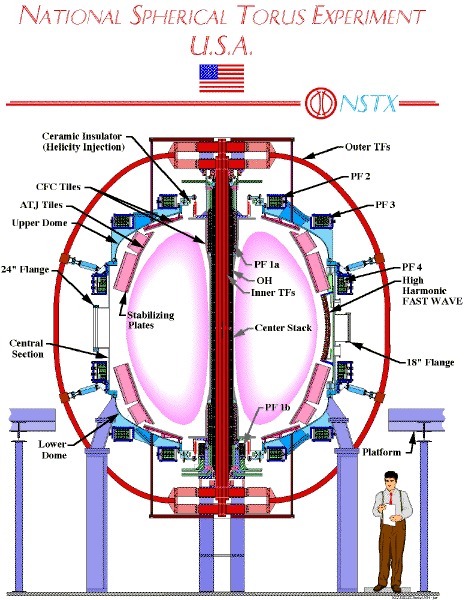Environment & Energy
Related: About this forumGiant structures called plasmoids could simplify the design of future tokamaks
http://www.eurekalert.org/pub_releases/2015-06/dppl-gsc060115.php[font size=5]Giant structures called plasmoids could simplify the design of future tokamaks[/font]
DOE/Princeton Plasma Physics Laboratory

IMAGE: Left: Plasmoid formation in simulation of NSTX plasma during CHI. Right: Fast-camera image of NSTX plasma shows two discrete plasmoid-like bubble structures. view more
Credit: Left: Fatima Ebrahimi, PPPL Right: Nishino-san, Hiroshima University
[font size=3]Researchers at the U.S. Department of Energy's Princeton Plasma Physics Laboratory (PPPL) have for the first time simulated the formation of structures called "plasmoids" during Coaxial Helicity Injection (CHI), a process that could simplify the design of fusion facilities known as tokamaks. The findings, reported in the journal Physical Review Letters, involve the formation of plasmoids in the hot, charged plasma gas that fuels fusion reactions. These round structures carry current that could eliminate the need for solenoids - large magnetic coils that wind down the center of today's tokamaks - to initiate the plasma and complete the magnetic field that confines the hot gas.
…
Ebrahimi ran a computer simulation that modeled the behavior of plasma and the formation of plasmoids in three dimensions thoughout a tokamak's vacuum vessel. This marked the first time researchers had modeled plasmoids in conditions that closely mimicked those within an actual tokamak. All previous simulations had modeled only a thin slice of the plasma - a simplified picture that could fail to capture the full range of plasma behavior.
Researchers validated their model by comparing it with fast-camera images of plasma behavior inside the National Spherical Torus Experiment (NSTX), PPPL's major fusion facility. These images also showed plasmoid-like structures, confirming the simulation and giving the research breakthrough significance, since it revealed the existence of plasmoids in an environment in which they had never been seen before. "These findings are in a whole different league from previous ones," said Roger Raman, leader for the Coaxial Helicity Injection Research program on NSTX and a coauthor of the paper.
The findings may provide theoretical support for the design of a new kind of tokamak with no need for a large solenoid to complete the magnetic field. Solenoids create magnetic fields when electric current courses through them in relatively short pulses. Today's conventional tokamaks, which are shaped like a donut, and spherical tokamaks, which are shaped like a cored apple, both employ solenoids. But future tokamaks will need to operate in a constant or steady state for weeks or months at a time. Moreover, the space in which the solenoid fits - the hole in the middle of the doughnut-shaped tokamak - is relatively small and limits the size and strength of the solenoid.
…[/font][/font]
Xipe Totec
(43,890 posts)
tularetom
(23,664 posts)But alas, every time I finished reading, I just felt dumber.
Since I assume your intention was not to make your readers feel dumb, could you explain this article in terms that could be understood by somebody who would not know a plasmoid from a tokamak if they both bit him in the ass.
Or maybe "it's just me", to coin a phrase![]()
OKIsItJustMe
(19,938 posts)This fusion takes place in a plasma. (Not to be confused with blood plasma.) There are three forms of matter we are quite familiar with, solid, liquid & gas. We deal with these every day. Plasma is a fourth form of matter! It is closest to a gas. If you’ve ever seen lightning, you’ve seen plasma.
Unlike a gas, plasmas can be shaped, using magnetic fields.
Some experimental fusion reactors (e.g. tokamaks) are shaped like a torus or donut. Plasma is contained inside the ring, using very powerful electromagnets, including a very large core.

In a “spherical tokamak” the design is compressed.

Plasma, when it is shaped/confined by a magnetic field is a “plasmoid.”
This study involves “thicker parts” of the plasma (if you will) i.e. “plasmoids.”
But, the more important thing about this study is that a computer model was able to predict the existence and shape of the plasmoids.
mackdaddy
(1,528 posts)If the earth gets sucked into the miniature black hole they create....![]()